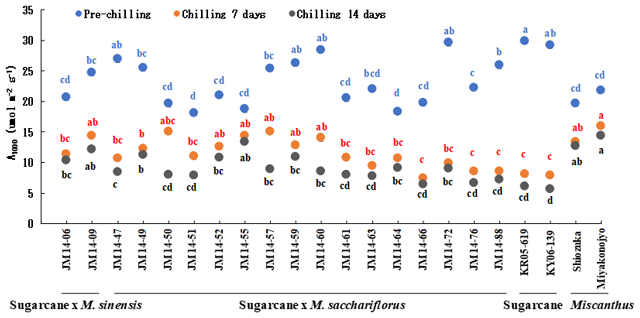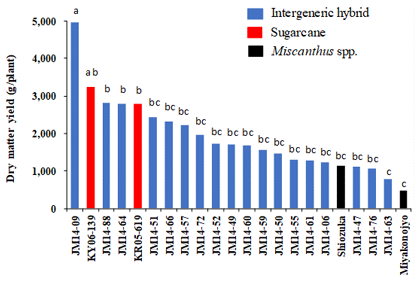Sugarcane and Miscanthus intergeneric hybrids: New sugarcane breeding materials with high photosynthetic activity in a low-temperature environment
Description
Sugarcane (Saccharum spp. hybrid) is an essential crop for food and energy production in the world, hence improving its productivity is required. Sugarcane is one of several high-yielding crops with C4 photosynthesis in tropical and sub-tropical areas; however, it is susceptible to low temperatures, and there are many production areas where low temperature is a major constraint in production. Therefore, improving its adaptability to low-temperature environments has been one of the important breeding targets in sugarcane. Among C4 plants, Miscanthus spp., a sugarcane-related genus, is highly adapted to low-temperature environments because of its cold tolerance during photosynthetic activity, thereby receiving attention as a biomass crop in cold-climate regions. This study aimed to develop new sugarcane breeding materials for improving cold tolerance in sugarcane by intergeneric hybridization between sugarcane and Miscanthus spp.
Using intergeneric crosses between sugarcane clones KY06-139 and KY05-619 as female and Shiozuka (Miscanthus sinensis) and Miyakonojo (M. Saccharifulorus) as male, we developed two hybrids between sugarcane and Shiozuka and 16 hybrids between sugarcane and Miyakonojo (Fig. 1). In the chilling stress experiment (12–13°C day/7–9°C night), the Miscanthus parents and some hybrids exhibited higher photosynthetic rates than their sugarcane parents after 7 days and 14 days of chilling treatment (Fig. 1). Furthermore, in the post-chilling recovery experiment, where chilling treatment (12°C day/7°C night) was applied for 4 days and then recovery treatment (26°C day/18°C night) was applied for 7 days, the Miscanthus parents and some hybrids showed better recovery of photosynthetic rates than the sugarcane parents (Table 1). Intergeneric hybrid JM14-09 showed higher biomass productivity than sugarcane parent KR05-619 and Miscanthus parent Shiozuka, based on the results of field experiments in a cold-climate region (Fig. 2).
To sum up, the intergeneric hybrids developed in this study can be utilized as new breeding materials for improving the biomass productivity and photosynthetic characteristics of sugarcane at low-temperature environments.
Figure, table
-
Fig. 1. Photosynthetic rates of intergeneric hybrids in the chilling treatment
The experimental materials were planted in plastic pots with three replications on October 28, 2016, and chilling treatment was started from December 22, 2016. Photosynthetic rates were measured pre-chilling (22–25°C day/13–15°C night) and after 7 and 14 days of chilling (12–13°C day/7–9°C night). A different letter indicates significant difference (p<0.05). The data show the photosynthetic rate at a photosynthetic photon flux density of 1,000 μmol m−2 s−1 (A1000). -
Table 1. Recovery of the photosyncetic rate after chilling treatment
Clone A1500 (µmol m-2 s-1)1) Pre-chilling2) Chilling 4 days3) Recovery 7 days4) JM14-09 28.8 b5) 17.1 (59) ab 29.9 (104) a JM14-72 33.2 a 14.8 (45) b 25.4 (177) b JM14-88 23.4 c 13.2 (56) b 24.0 (103) b KR05-619 28.3 b 9.3 (33) c 20.5 (172) c KY06-139 29.3 b 9.5 (32) c 20.3 (169) c Shiozuka 24.2 c 16.0 (66) b 24.9 (103) b Miyakonojo 29.9 b 19.7 (66) a 28.9 (197) a 1) The photosynthetic rate at a photosynthetic photon flux density of 1,500 μmol m−2 s−1. 2) Photosynthetic rates were measured five weeks after planting (26°C/18°C day/night). 3) Photosynthetic rates were measured after 4 days of chilling treatment (12°C day/7°C night). 4) Photosynthetic rates were measured after 7 days of recovery treatment (26°C day/18°C night). 5) A different letter indicates significant difference among the treatments (p<0.05). The values in parentheses in the table indicate the ratio to the photosynthetic rate of pre-chilling.
-
Fig. 2. Dry matter yield per year in the cold-climate region
The experiments were conducted for two years, in 2017 and 2018, at the fields in Hokkaido University (Sapporo, Japan: 43°07′N, 141°33′E). The experimental materials were planted in May and harvested in November, and the experimental plots were three replications with one plant per plot. The average temperature and precipitation in the experimental period were 17–18°C and 700–800mm, respectively. A different letter indicates significant difference (p<0.05).
- Affiliation
-
Japan International Research Center for Agricultural Sciences Tropical Agriculture Research Front
- Classification
-
Technical A
- Research project
- Program name
- Term of research
-
FY2019 (FY2016-FY2020)
- Responsible researcher
-
Teraiima Yoshifumi ( Tropical Agriculture Research Front )
Ando Shotaro ( Tropical Agriculture Research Front )
Kar Suraj ( Hokkaido University )
Toshihiko Yamada ( Hokkaido University )
- ほか
- et al.
- Publication, etc.
-
https://doi.org/10.1111/gcbb.12632
Kar S et al. (2019) GCB Bioenergy, 11(1):1318-1333
https://doi.org/10.1007/s12155-019-10066-xKar S et al. (2019) BioEnergy Research
- Japanese PDF
-
2019_B05_A4_ja.pdf772.94 KB
2019_B05_A3_ja.pdf198.06 KB
- English PDF
-
2019_B05_A4_en.pdf129.16 KB
2019_B05_A3_en.pdf188.96 KB
- Poster PDF
-
2019_B05_poster_fin.pdf338.14 KB


